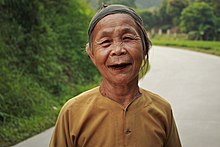You can help expand this article with text translated from the corresponding article in Vietnamese. Click for important translation instructions.
|
| Người Sán Chay | |
|---|---|
 | |
| Total population | |
| 252.000 (2019) | |
| Regions with significant populations | |
(Northern Vietnam, Central Highlands and Tuyên Quang) | |
| Languages | |
| Cao Lan, Pinghua Chinese, Vietnamese | |
| Religion | |
| Buddhism | |
| Related ethnic groups | |
| Zhuang, Buyei |
The San Chay people (Vietnamese: Người Sán Chay; also called Sán Chỉ) live in Tuyên Quang Province of the Northeast region of Vietnam, as well as some nearby provinces. The Pinghua language is a form of Chinese language. Their population was 201,398 in 2019.
Many live in remote areas, using slash-and-burn agriculture because those areas are not flat enough for paddy rice production.
They sing sình cồ (love songs) and celebrate the Slếch thlin mảy festival (New Rice festival).
The San Chay people are related with the Shanzi People in Guangxi, China.
References
- "Report on Results of the 2019 Census". General Statistics Office of Vietnam. Retrieved 1 May 2020.
- Kết quả toàn bộ Tổng điều tra dân số 2019. p. 44. Trung tâm Tư liệu và Dịch vụ Thống kê, Tổng cục Thống kê, 19/12/2019. Truy cập 1/09/2020.
- Jean Michaud (19 April 2006). Historical Dictionary of the Peoples of the Southeast Asian Massif. Scarecrow Press. pp. 257–. ISBN 978-0-8108-6503-7.
- Jean-Christophe Castella (2002). Doi Moi in the Mountains: Land Use Changes and Farmers' Livelihood Strategies in Bac Kan Province, Viet Nam. Int. Rice Res. Inst. pp. 11–. ISBN 978-971-22-0270-4.
- He Siyuan (1 Jan 2019). "广西十万大山山子话音系及核心词分析 / An Analysis on Phonology and Core Words of Shanzi Dialect of Shiwan Dashan of Guangxi". 百色学院学报 / Journal of Baise University. 32.
External links
| Ethnic groups of Vietnam | |
|---|---|
| Austroasiatic (Vietic) | |
| Austroasiatic (non-Vietic) | |
| Hmong–Dao | |
| Tai–Kadai | |
| Sino-Tibetan (Chinese) | |
| Sino-Tibetan (Tibeto-Burman) | |
| Malayo-Polynesian | |
| Immigrants and expatriate | |
The 54 officially recognised ethnic groups are ranked by population in their language families according to 2019 census
| |